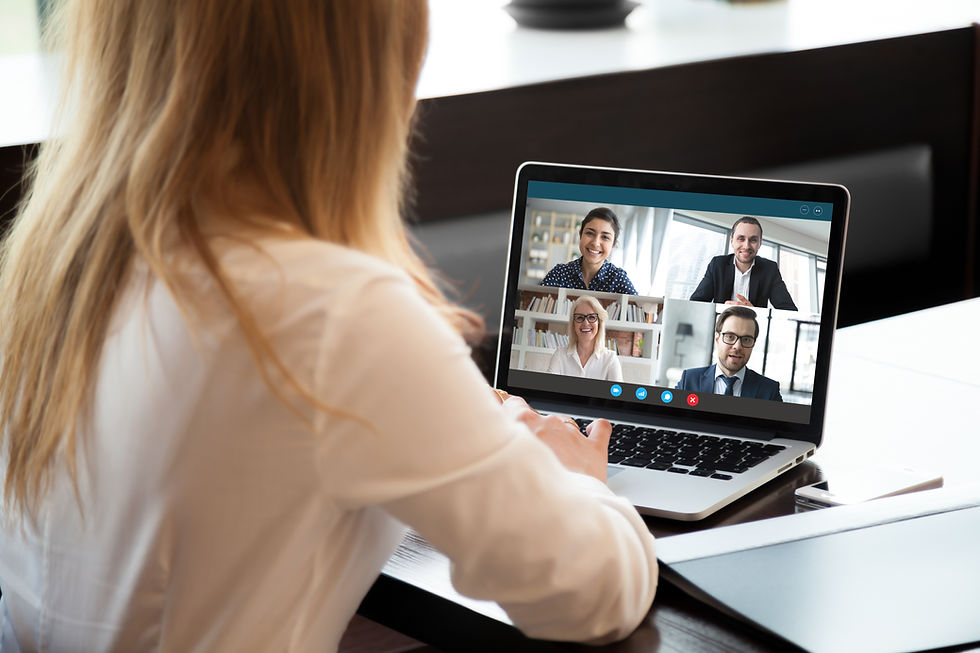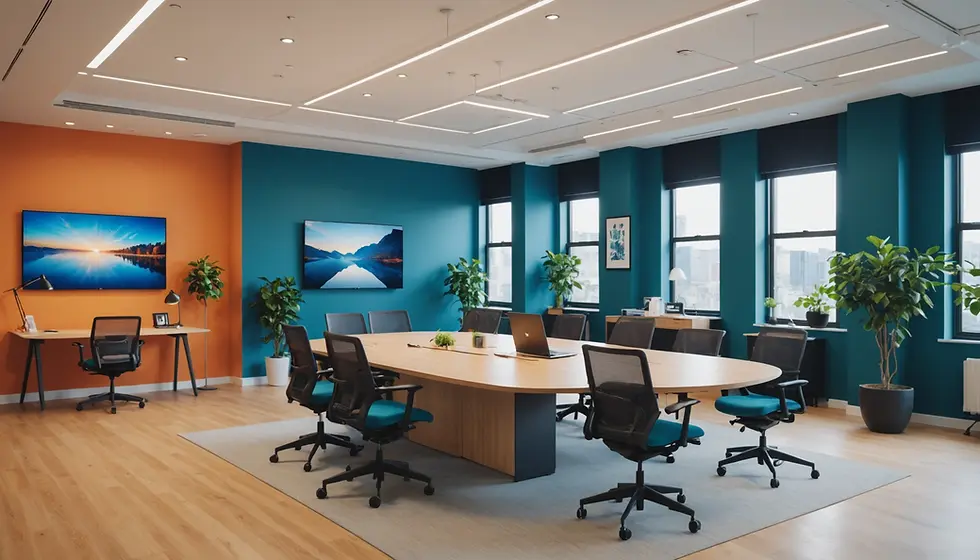Tips for a Successful Virtual Interview
- Tracey Orosz

- Apr 19, 2021
- 6 min read

There are two types of video interviews — live interviews (using Zoom, Skype, FaceTime, or LiveMessenger) and recorded Question-and-Answer interviews, also called “time-shifted” video interviews.
In a recorded interview, the jobseeker is directed to a website to answer questions on video, using their computer’s webcam. Video interviews provide an apples-to-apples approach to assessing candidates. All applicants are asked the same questions, and the hiring manager can review and rate the responses. These interviews can be easily set up by the company’s HR staff and the recording forwarded to the hiring manager for selection for the next round of interviews.
Some of the technology providers for time-shifted video interviews include:
- HireVue (www.hirevue.com)
- InterviewStream (www.interviewstream.com)
- Take the Interview (www.taketheinterview.com)
- JobOn (https://www.jobon.com/)
- VideoView (https://videoview.com/)
More common, however, are live video interviews.
A recent survey by OfficeTeam found that 63 percent of HR managers use video technology to conduct job interviews. This number has obviously significantly increased in the past year due to the pandemic transitioning virtually all job interviews online out of necessity.
Skype and Zoom usage have increased dramatically in recent years: more than 300 million minutes of video calls are logged every day. An increasing number of those calls are job interviews.
Video Interview Preparation
You can conduct a video interview on a laptop with a webcam, a traditional computer with a webcam, or using an app on your phone or iPad.
Even though the interview is being conducted by webcam, this is a “real” live interview, and you should be as prepared as if you were sitting across the desk from the interviewer. In fact, you may have to prepare more! After all, you do not have to clean your room before going off to an in-person job interview, but you do need to clear a space for your Skype interview.
Be mindful of where you set up for your video interview. Be sure the area is free of visual distractions (clutter). Carefully consider what is in the background of your Skype interview. Make the background interesting, but not distracting. Plain white walls are fine, but boring. Can you frame a desk or bookshelves behind you instead?
Check out your technology well in advance of the interview. Make sure you have Internet connectivity and that your webcam and microphone are working. You may also have to download the software if it is the first time you are using the application.
One of the best things you can do to prepare for a live video interview is practice. Practice doing a couple of virtual interviews with friends or family members before your job interview. Check the lighting and your volume.
Recording your practice video interview can help you identify areas to work on, or fix. Have your test partner take a few screenshots if you cannot record the call. You want to make sure your webcam is providing a decent picture. (High definition webcams are available for under $100 if yours is not providing a clear picture.)
Clarify with the interviewer who will initiate the video call and double-check the username. Also be sure to account for any time zone differences.
Video Interview Do’s and Don’ts
Keep these “do’s” and “don’ts” in mind.
DO:
Dress nicely — more than one jobseeker has scheduled a virtual interview, thinking it would be voice only — and then accidentally found himself or herself on a video call.
Dress from head-to-toe. You may think you do not need to wear dress pants with the shirt and tie since the interviewer is only going to see the top half of your outfit. But you should always expect the unexpected. You never know when you might need to stand during an interview. Pajama pants or shorts with a dress shirt, tie, and jacket just do not work.
Keep your clothing color choice in mind. Check how the colors of your clothing appear on camera. Just like TV news anchors avoid some colors — and most small patterns, pick colors that will show up well on video. Jewel tones or pastel colors work best. Do not wear white or black.
Practice your interview wearing the exact outfit you are planning to wear. This trial run will also allow you to test the volume of your system, see how the software works (if you are not familiar with the app), and make sure your lighting is appropriate.
Lighting is important for virtual interviews. If the light source is behind you, you may appear as a dark silhouette on the screen. Position a lamp or other light source in front of you.
Ensure that your profile photo is professional. This is your first impression from a physical standpoint in a video conference.
Positioning is also important. Prop up the computer so that you are not looking down at it and practice where to sit so you are framed correctly by the webcam. Make sure your torso is visible — including your hands — especially if you “talk” with your hands.
Look at the webcam when you speak, not at the interviewer’s face on your screen. When you look into the camera, it appears to the interviewer that you are looking at them directly.
One “pro” tip is to use a USB-connected headset for an interview instead of using the computer’s speakers. Headsets are inexpensive and can provide a much clearer interview experience.
If possible, use a wired Internet connection (plug directly into the Ethernet port) instead of using a wireless connection.
If you are using a laptop for the session, plug it in so you have plenty of “juice” (battery life) for the call. You do not want to have to dig for a cord to keep the computer from shutting down.
Turn off notifications on your computer and close your other software programs. You do not want to be distracted by beeps every time you receive an email.
Speaking of distractions, it is easy to tell on a video interview if you are not paying attention, so keep your focus on the interviewer.
Dial up the enthusiasm! Someone who speaks with normal energy in a one-on-one conversation can come across as flat and monotone on a video interview. So it is important to be a little more enthusiastic in a virtual interview than normal.
Smiling is an important strategy for video interviews. Most of the time, when we are listening to someone else, we have a blank expression on our face. But on a video interview, a blank expression comes across as a frown. Keep a slight smile on your face: not a huge grin, just show a few teeth and raise your cheeks slightly. Practice this in a mirror ahead of time.
Lean in. You have probably heard that “the camera adds 10 pounds.” The reason for this is that many people lean backwards in their chair, when they should be leaning forward. If you sit back and relax in your chair your head will be further away from the webcam than your stomach. Unfortunately, the camera latches on to whatever is closest…your gut!
For women, pay careful attention to your hair and makeup in video interviews. Again, a practice virtual session can help you assess this.
Be mindful of your nervous habits. Just like in a face-to-face interview, the interviewer will notice when you twirl your hair or chew your lip.
You can take notes during a virtual interview, but do not take too many, or you will come off looking distracted. Take notes with a pen and paper, not on your computer.
If you have an online portfolio, keep the link handy. You may want to share it with your interviewer.
DO NOT:
Choose a cutesy or unprofessional screen name — no nicknames and minimize numbers and keyboard characters. Online, your first impression is your username and photo, so make sure both are professional. Your best bet is your first name and last name as your username.
Forget to verify the timing of your virtual interview — taking into account any time zone differences.
Be too quick to answer. With video, there is sometimes a delay or interference, so make sure you pause before answering a question to avoid talking over the interviewer.
Forget to silence your cell phone when you are on a video interview.

At The End of the Interview
As with an in-person interview, be sure to inquire about what the next step will be. And write a handwritten thank you note or email as soon as you are off the call.
Follow-up is key after a video interview. Research indicates that employers are less likely to keep jobseekers up-to-date about their prospects with the company after a virtual interview than with an in-person interview.
Checklist for a Virtual Interview
Print out a hard copy of your résumé (make sure it is the same version the interviewer has), cover letter, and the job posting/job description.
Prepare your list of questions you want to ask in the interview.
Assemble your talking points and company research.
Record a professional voice mail message on your phone.
Have a glass of water nearby in case your throat gets too dry.
If using a cell phone, have your phone charger and an outlet nearby.
If using a laptop, make sure it is plugged in and is charging.
Eliminate any distractions and put up a “Do Not Disturb” sign.
Have your calendar or schedule handy in case you are asked to schedule your next interview.









Comments